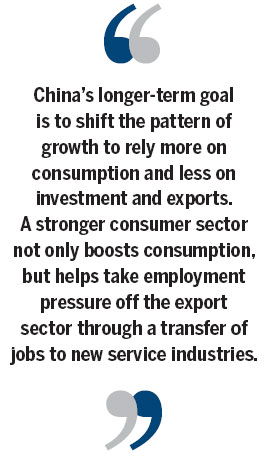It's what comes in that matters
Updated: 2013-02-01 09:12
By Oliver Barron (China Daily)
|
|||||||||||
Few new policies are needed to support exports, but China must focus on long-term import goals
China's trade fell shockingly short of its target in 2012, raising questions about the outlook for 2013 and what authorities must do to boost trade this year.
The Ministry of Commerce targeted a 10-percent increase in total trade in 2012, which government officials clarified as including a 12-percent increase in imports and an 8-percent increase in exports. For the year, the value of China's trade reached $3.87 trillion, made up of $2.05 trillion in exports and $1.82 trillion of imports, resulting in a trade surplus of $231 billion. Total trade was up 6.2 percent, exports up 7.9 percent, imports up 4.3 percent and the trade surplus was up a whopping 49.2 percent, the largest growth since 2006.
 |
Contrary to popular belief, therefore, it was not exports, which rose 7.9 percent (against a target of 8 percent) that caused China to miss its trade target, but rather the 4.3-percent increase in imports, far short of the 12-percent target.
There are two primary reasons for the poor import figures. First and most importantly, weakness in the domestic economy for much of the year led to reduced demand for imports. Second, commodity prices were generally lower in 2012 than 2011, hitting the value of imports.
While the latter reason is due to many factors globally, China can at least take comfort in the fact that the domestic economy is improving after many measures from the government to stabilize growth through infrastructure investment. Import volumes should continue rising in 2013.
Still, the focus, as always, is on the export sector, which accounts for a significant share of employment and is therefore closely linked to domestic stability. While stability is always the primary consideration of the government, it is even more so during the first year of China's new leadership.
The main issue for exports is demand in the European Union and the United States, which together account for 37 percent of exports. If Japan is added to the equation, this rises to 45 percent. Looking ahead to 2013, while there may be some reason for optimism, there is also reason for concern.
In the EU, one could be tentatively optimistic after the 2.3 percent year-on-year rise in Chinese exports to Europe in December following six consecutive months of decline, but politics and economics will again collide with parliamentary elections in Italy in February and Germany in September. Any change in governments could affect regional stability and slow growth in a region that is already in recession.
In the US, if political differences over raising the debt ceiling and required spending cuts of more than $1 trillion are not resolved in the coming months, the economic recovery could be derailed. Meanwhile, exports to Japan could remain weak due to ongoing international disputes and the fact that policymakers in Japan are actively trying to weaken the Japanese yen, which while good for imports, hurts exports to Japan.
Even with these issues in major developed economies, the overall outlook is not so bad. The National Development and Reform Commission has tentatively proposed an 8-percent trade target for 2013, a level already achieved by exports in 2012 in what was an admittedly weak external environment. This means few new policies are needed to support exports at their current level.
Still, to limit downside risk, China must continue to diversify its export markets. The proportion of total exports that goes to ASEAN nations is up 2.2 percent, and to Latin America by 2.4 percent since 2007, while the proportion to the EU is down 3.8 percent and to the US by 1.8 percent. This trend must continue, allowing China to benefit from growth in new emerging markets.
But despite its vital role in employment, the key issue for 2013 should not be exports, but imports. China's longer-term goal is to shift the pattern of growth to rely more on consumption and less on investment and exports. A stronger consumer sector not only boosts consumption, but helps take employment pressure off the export sector through a transfer of jobs to new service industries.
The new leadership has been increasingly vocal about making these structural adjustments, but concrete steps must be taken to achieve these goals once they officially take office in March. While much work is needed, lower import tariffs on consumer goods and income tax reform to boost disposable income would be good first steps.
The author is head of the Beijing division of NSBO China, a Chinese government policy investment research firm based in the United Kingdom. The views do not necessarily reflect those of China Daily.
(China Daily 02/01/2013 page7)
Today's Top News
List of approved GM food clarified
ID checks for express deliveries in Guangdong
Govt to expand elderly care
University asks freshmen to sign suicide disclaimer
Tibet gears up for new climbing season
Media asked to promote Sino-Indian ties
Shots fired at Washington Navy Yard
Minimum growth rate set at 7%
Hot Topics
Lunar probe , China growth forecasts, Emission rules get tougher, China seen through 'colored lens', International board,
Editor's Picks

|

|

|

|

|

|





